Valentine’s Day is this Thursday, and Go Green BK is all about loving our environment. We can love each other, our communities, and our shared planet by stewarding the resources we have. Our friend, José Miguel López, has a great love for the beautiful trees in our North Brooklyn neighborhood. Read on to get a little lesson in love, through the story of a simple public holiday tree in McCarren Park!
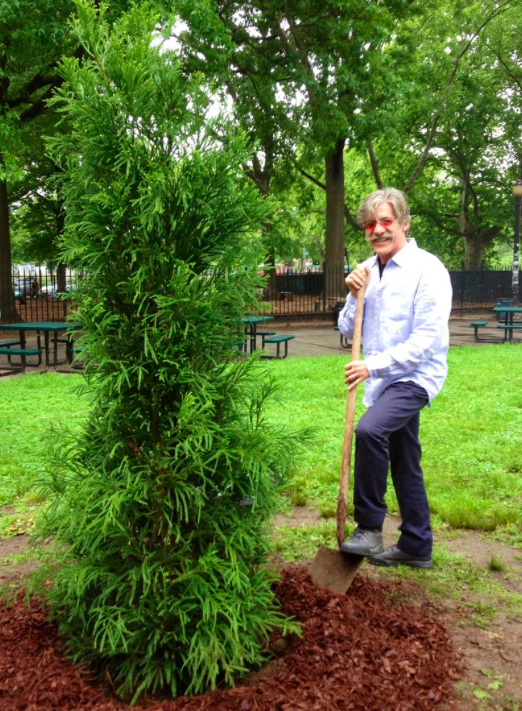
Geraldo’s Tree
As my nine-year-old Ximena and I strolled down Manhattan Avenue after days of Arctic weather, slowly heading to the farmers market at McCarren Park, the weak sunrays and barely above freezing temperature tricked us into thinking it was spring. By the time we actually got there, close to noon, it was already cloudy and many of the stalls were clearing up. But we weren’t there to shop—we were there to meet a tree.
We cut across the market and easily found the court, right between the fenced Dome Garden and the dog run at the corner of Driggs Avenue and North 10th. There it was, standing proudly in the middle of the muddy court against the façade of the Cathedral of the Transfiguration, slender and tall, still very young looking and fiercely green. If this was, in fact, our subject—and I was almost positive it was—then it must be close to 11 years old, almost two full years older than my daughter, who now stands next to it admiring its beauty up close. The tree just seemed a tad smaller than I imagined. “Look, papa, it still has ornaments on!” I get closer and see the little silvery balls left at the base of a branch from past holidays—this is definitely our tree, Geraldo’s tree.
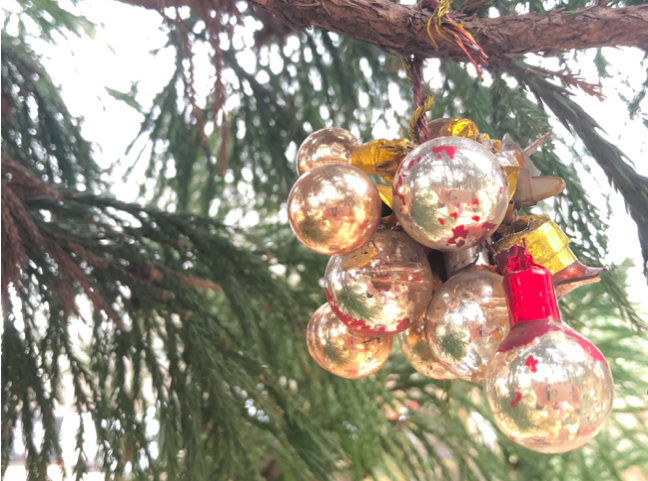
So, why is there a tree in McCarren Park named after Geraldo Rivera? The story—like so many tree stories in the area—is connected to the last time we got hit by a Super Storm. As many of us remember, in October 2012, Sandy unleashed its fury on this corner of the planet, devastating whole neighborhoods and reshaping shores. Many long standing trees were toppled not only in McCarren Park, but all over the city. In fact, an estimated 20,000 trees fell victims to the storm through the five boroughs. One of these victims was a beloved blue spruce (it’s been identified as a white spruce as well) donated by Geraldo Rivera in the early nineties. Rivera’s connection to Williamsburg goes back to the 1940s. As it turns out, one of the most recognized mustaches on American TV has its own roots not far from the McCarren Park, on Marcy Avenue, where Geraldo lived during most of his early childhood.
The community’s affection for the tree must have grown in a few years. In a book that bears the curiosity-inducing title Gods of the City: Religions and the American Urban Landscape, author Robert A. Orsi tells us about the “Winter Tree Festival,” en event organized since 1992 with the idea of bringing together different Christian communities to decorate Geraldo’s white spruce in the winter season. By the time the tree was uprooted by the powerful storm winds, the 40-feet giant had been for decades an important gathering place for the community: a site for book readings, environmental activities, family gatherings and Christmas parties. The loss of the “Nondenominational Yet Festive Winter Tree,” as one of the stories reporting the incident calls it, was deeply felt by neighbors—dear communal memories came crashing down with the spruce the day of the storm. People talked about harvesting the wood to make park benches as way to keep those memories alive, but I couldn’t confirm if that ever happened.

Six months after the tree fell, now more than five years ago, Geraldo Rivera came back to the rescue and planted this new evergreen to replace the original spruce, in an event that was reported and documented by several local news sources. And here it is, obliviously swaying as the wind starts to pick up and the air feels a little colder. This almost eleven-year old replacement, or Geraldo II, as some have called it, is certainly beautiful. The soft, scaly leaves drop elegantly on its branches, some of which show its thorny, cracked pinecones. It looks healthy and strong, flexible, ready to weather anything mother nature might throw its way, specially when compared with the discarded pines at the edge of the court that already served their short-lived function as centerpieces for holiday decoration. Seeing it there, next to my daughter, is easy to see its brilliant future. But I don’t think it will really ever look like the fallen spruce.
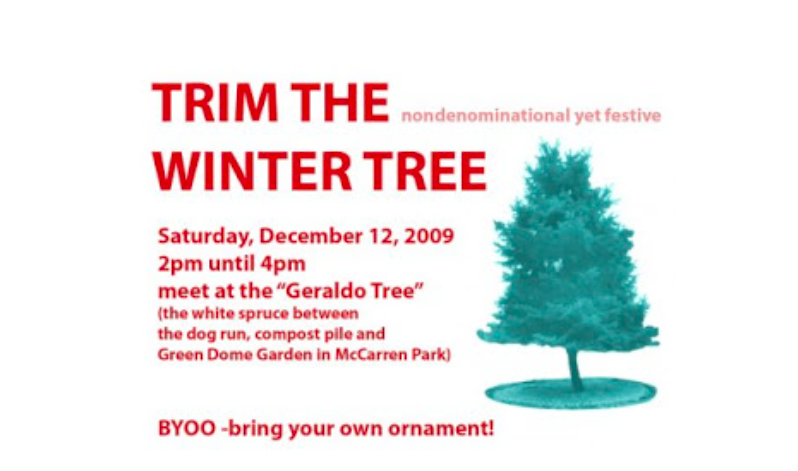
An Identity Problem
According to a Brooklyn Paper story by Danielle Furfaro, Geraldo II is also a spruce, though she doesn’t say exactly what type of spruce. James Kaechele, development manager at NY Tree Trust when the tree was planted, predicted that the sapling would grow up to a foot a year and perhaps reach up to 40 feet like the old Geraldo spruce.
PlantSnap, however, insists this young tree is not a spruce, but a Cryptomeria japonica, or Japanese Cedar, also known as Sekkan Sugi. After looking at different pictures of the species online, I have to agree with PlantSnap’s ID algorithm. The cones and leaves I found online are almost identical to the ones in our young tree.
The Japanese Cedar is a needled evergreen of the Cupressaceae family native to Japan and Southern China. It is in fact, as the Missouri Botanical Garden plant finder tells me, the national tree of Japan, where it is frequently found in growing on the grounds of temples and shrines. It is a low maintenance conifer, probably one of the important reasons why it was included in a spring of 2009 reforestation report from Parks and Recreation as one of the species planted in the New York City parks, including McCarren. Japanese Cedars can grow as high as 50 to 60 feet, so it is very possible Geraldo II will be as tall as Geraldo the spruce.
Regarding that old beloved spruce, it is hard to confirm its species. It probably was a blue spruce, as most stories report, but it is hard to know if this is true just by looking at the two only images I could find, specially since one of them labels it as a white spruce. What matter is that the memories that lost tree gathered over the years will live on this lovely Japanese cedar for many years to come.
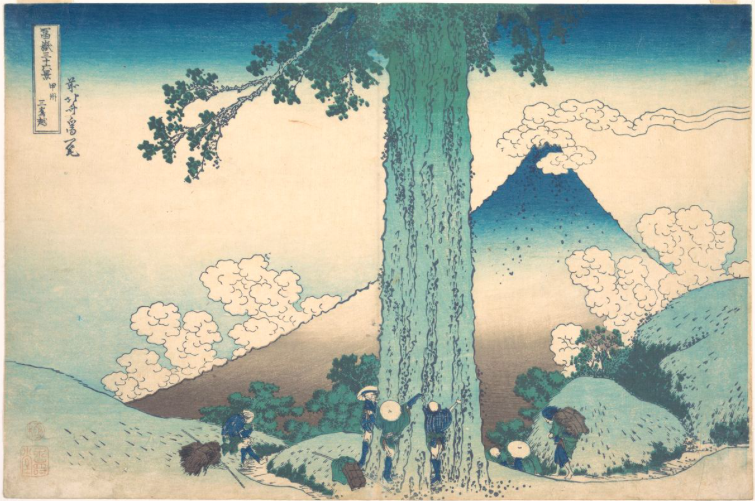
Let the Tree Speak
Though I had a somewhat clear idea of what I wanted to say when I finally decided to follow the suggestion to write about Geraldo’s Tree, I just couldn’t get going. More than I week elapsed between my first visit to the Cryptomeria japonica and my second one, on the eve of the Chinese New Year. I was stocked. Suddenly, I realized what the problem was: I was afraid that the TV flashy personality would overshadow the tree. So I decided to pay another visit to the Geraldo II. The moment I saw that little cedar again beneath the blue February sky all my reservations were gone. Young members of the community like my daughter will not remember Geraldo Rivera as the man who opened an empty vault in Chicago, or as the host of a sensationalist talk show, or as a Fox News anchor man. Instead they will probably remember him as the man who planted a lovely tree for the community not once, but twice. Is there a better way to be remembered—if such happens to be a person’s ambition—than by a celebrated tree?
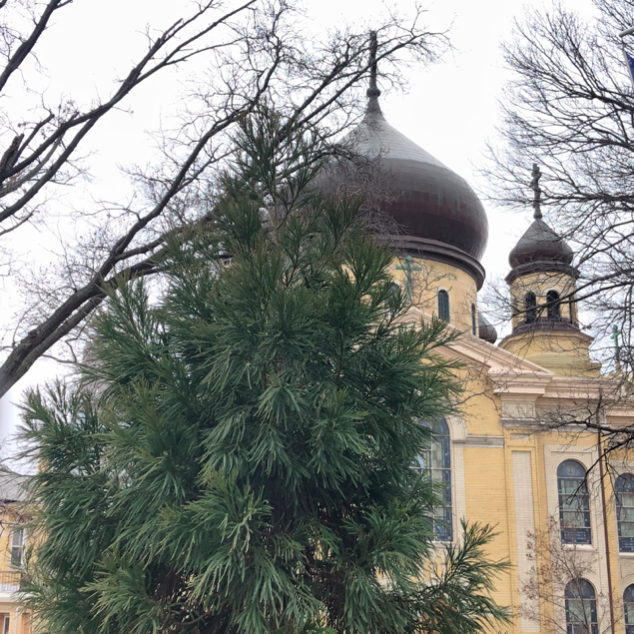
At a time of political tensions, when every aspect of reality seems to be sucked into a vortex of irreconcilable differences, this tree stands here as a living sample of what really matters. Its slowly expanding girth and the shadow it projects is our common ground. This is not just hippie talk: trees make better, safer communities—on top of all the obvious benefits of green, lushy areas, studies have suggested that trees actually do help reduce crime in troubled areas. Geraldo’s gift is a real community treasure, and thinking that the tree’s better years are still to come makes me hopeful for the future. Not many things can do that these days.
***
More Tree Tales from GoGreen BK:
- The Holly King. José Miguel López. December 17, 2018
- Call of the Catalpa. José Miguel López. November 19, 2018
- An Oak Tree Grows in Greenpoint. José Miguel López. October 18, 2018
- Greenpoint Had a Fig Tree. José Miguel López. September 19, 2018
- Poet Tree. José Miguel López. April 5, 2018.



